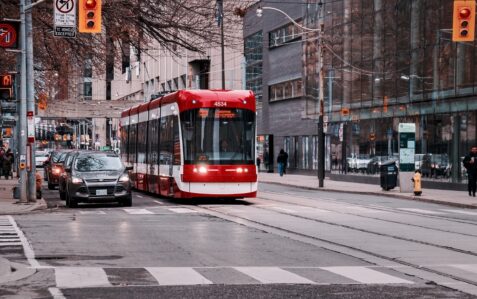The Worst Intersections in Toronto for Car Accidents
The bustling city of Toronto, known for its diverse culture and vibrant energy, is also home to a complex network of roadways and intersections. While these intersections are essential for efficient transportation, some have gained a notorious reputation for being accident-prone. Understanding the dynamics behind these problematic junctions is not only crucial for drivers but also for the safety of the community at large. Here are Toronto’s worst intersections for car accidents.
Toronto’s Most Dangerous Intersections
Spadina Avenue and Lakeshore Boulevard West – The intersection of Spadina Avenue and Lakeshore Boulevard West features multiple lanes, pedestrian crossings, and streetcar tracks, leading to increased congestion and confusion. Heavy traffic volumes are common, particularly during rush hours and major events, exacerbating the potential for collisions. Frequent changes in traffic signals and turns add to the complexity, catching drivers off guard.
Dundas Street West and Dupont/Annette Streets – The intersection of Dundas Street West and Dupont/Annette Streets has multiple lanes, turning options, and pedestrian crossings, creating potential confusion for drivers. The intersection’s proximity to major arterial roads and residential areas results in high traffic volumes and frequent congestion, increasing the likelihood of accidents. Varying speed limits and abrupt lane changes contribute to the intersection’s challenges, and the presence of streetcars along Dundas Street West adds an extra layer of complexity.
Davenport Road and Dufferin Street – The intersection of Davenport Road and Dufferin Street is complex, involving multiple lanes, turning options, and pedestrian crossings, which can lead to confusion among drivers. The heavy traffic volume, especially during peak hours, escalates the risk of collisions. Its proximity to major arterial routes and residential areas causes abrupt changes in traffic flow and intensifies congestion and the potential for accidents.
Markham Road and Tuxedo Court – The intersection of Markham Road and Tuxedo Court has multiple lanes, turning options, and pedestrian crossings, creating opportunities for driver confusion. It experiences high traffic volume, particularly during rush hours, leading to congestion and increased collision risks. It’s situated near residential areas and shopping centers, resulting in diverse traffic patterns and frequent stops. The irregular terrain and limited visibility in some sections also add to the challenges.
Midland Avenue and Sheppard Avenue – The intersection of Midland Avenue and Sheppard Avenue possesses a complex design with multiple lanes, turning options, and pedestrian crossings, often leading to driver confusion and misjudgments. It’s a hub of commercial and residential activity, resulting in heavy traffic congestion during peak hours. The presence of public transportation, including buses, further intensifies the complexity of the intersection. Varying speed limits and abrupt lane changes also increase the accident risk.
Lower Jarvis Street and Lakeshore Boulevard – The intersection of Lower Jarvis Street and Lakeshore Boulevard has multiple lanes, turning options, and streetcar tracks, leading to potential confusion for drivers. Its proximity to the waterfront and popular attractions makes it a hub for tourists and locals, resulting in heavy traffic and frequent congestion. Frequent changes in traffic signals and pedestrian crossings add to the intersection’s complexity, and the mix of commuting vehicles, cyclists, and pedestrians can create challenging traffic dynamics.
Factors that Contribute to Car Accidents in Intersections
Car accidents at intersections can be attributed to a multitude of factors, making these areas particularly susceptible to collisions:
- Running Red Lights – One of the most common factors is drivers running red lights or disregarding stop signs, often due to impatience or distraction.
- Speeding – Excessive speed, especially when entering an intersection, reduces reaction time and increases the severity of accidents.
- Distracted Driving – Using smartphones, adjusting the radio, or engaging in other distractions diverts a driver’s attention away from the road, making accidents more likely.
- Obstructed View – Buildings, parked vehicles, or landscaping can obstruct a driver’s view of oncoming traffic or pedestrians.
- Weather Conditions – Fog, rain, snow, or glare from the sun can reduce visibility and make it challenging to assess the traffic situation.
- Gridlock – Heavy traffic and gridlock can lead to intersection blockages, making it difficult for drivers to proceed safely.
- Bottlenecks – Narrowing or congested lanes before an intersection can increase the risk of rear-end collisions.
- Crosswalks and Bike Lanes – Intersections often involve pedestrians and cyclists, and a lack of respect for their right-of-way can lead to accidents.
- J-Walking – Pedestrians crossing outside designated crosswalks can catch drivers off guard.
- Failure to Yield – Drivers not yielding the right-of-way when required, especially during left turns, contributes to many intersection accidents.
- Misjudging Speed – Drivers often misjudge the speed of oncoming vehicles when making left turns.
Toronto intersections remain hotspots for car accidents due to a combination of factors. The experienced car accident lawyers at Franklin Law Firm are here to provide you with the legal support and guidance you need to protect your rights and seek fair compensation when navigating the aftermath of an intersection accident. Contact us today for a consultation.


